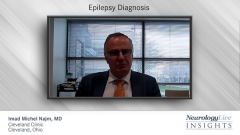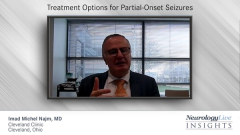
Best Practices for Patient Compliance in Epilepsy Treatment
An expert neurologist outlines best practices to consider in epilepsy therapy to increase patient compliance.
Imad Michel Najm, MD: It is always in our minds, as practitioners—when we are trying to come up with a treatment strategy for our patients with the diagnosis of epilepsy—to find the best option. As an epileptologist, when I think about it, I have to answer the first question: Is it epilepsy or not? If it is epilepsy, do I think this epilepsy is primary, generalized epilepsy? Is it partial epilepsy, or focal epilepsy? The third question I will try to answer is what type of seizures does the patient have, or what are their major seizures? For example, if the patient is having generalized convulsive seizures, that is quite different from focal seizures. Some medications are better against generalized convulsive seizures.
The second thing—generalized convulsive seizures—present a bigger danger to the patient because of complications and a significant increase in sudden unexplained deaths, and deaths in general, in these patients with epilepsy. Having gone through this initial assessment algorithm—I think about that every time I see a patient for the first time—the next question will be, what is the best medication? How do we choose the best medication? We choose the best medication based on multiple factors. Some are specific to the medication. Some are specific to the patient; it is an individualized thinking.
From the medication standpoint, I like to choose a medication dosed once a day if possible. I would like to choose a medication with a longer half-life. I like to choose a medication that works on generalized convulsive seizures, that are partially onset to secondary generalizations or are primary generalized convulsive seizures. At the same time, they do work for patients who experience focal or partial seizures. I would like a medication that does not interfere with others the patient is taking or will be taking. I would like a medication that is cognitively benign or cognitively neutral. This means it does not affect memory and cognitive function to the extent that the patient would be missing medications if they have these types of adverse effects.
Of course, I would like for the patient not to experience an increase in weight. For many of our patients, almost all of us would be much more resistant to them taking medication with this type of adverse effect. Of course, if the patient has any other comorbid psychological conditions, we would make sure that the medication the patient is taking is not destabilizing to their mood. There are multiple factors. We also look at the medication while considering the type of seizures and epilepsy. At the same time, we try to find out what the patient profile is—from a medical standpoint, from a cognitive standpoint, and from a psychological standpoint. We try to blend these 2 together using a medication that has a longer half-life and is easier to take, rather than prescribing a medication with a shorter half-life, or 1 that needs multiple dosings per day.
To increase compliance, there are multiple strategies practitioners can take. No. 1 is to make sure we highlight, for the patient, that medications are extremely important to control seizures. If the patient does not take the medication or is not taking medication, they are at risk of being involved in car accidents. They cannot drive. If they do risk driving, they and others on the road are at a higher risk. The patient is putting themselves at risk of sudden unexplained death, and they may be prone to injuries from these seizures.
It is very important that the patient tries to understand the seriousness of their condition and, at the same time, the consequences of continued seizures. This is a fine line; there is a fine line between highlighting the seriousness of a condition and trying not to scare the patient. This is No. 1: to make sure the patient understands why we are treating them and why epilepsy is a serious illness if their seizures are not controlled. Second, we make sure we explain, to the patient, that we do not cure epilepsy. We control seizures as long as we are taking the antiseizure medications.
If we do not take the antiseizure medications once a day, we are at a risk for that day—the patient risks having their seizures come back. This is what we call breakthrough seizures. The third thing is that we have to make sure we emphasize, to the patient, that if they experience an adverse effect on a medication, we have ways to control this. To avoid the adverse effects or decrease the adverse effects, we start our patients at a lower dose and move up the treatment slowly, so we’ll be able to stop at a dose that, for the majority of patients, is well tolerated or better tolerated. It also has to be, at the same time, effective. To sum it up—the best way to get compliance from the patient is to make sure the patient understands why we are giving them a certain medication. Second, we must give them a medication with a long half-life and once a day dosing if at all possible. We have to make sure we inform the patient of our strategy, which is basically to start low and go up slow.
Transcript Edited for Clarity
Newsletter
Keep your finger on the pulse of neurology—subscribe to NeurologyLive for expert interviews, new data, and breakthrough treatment updates.


































